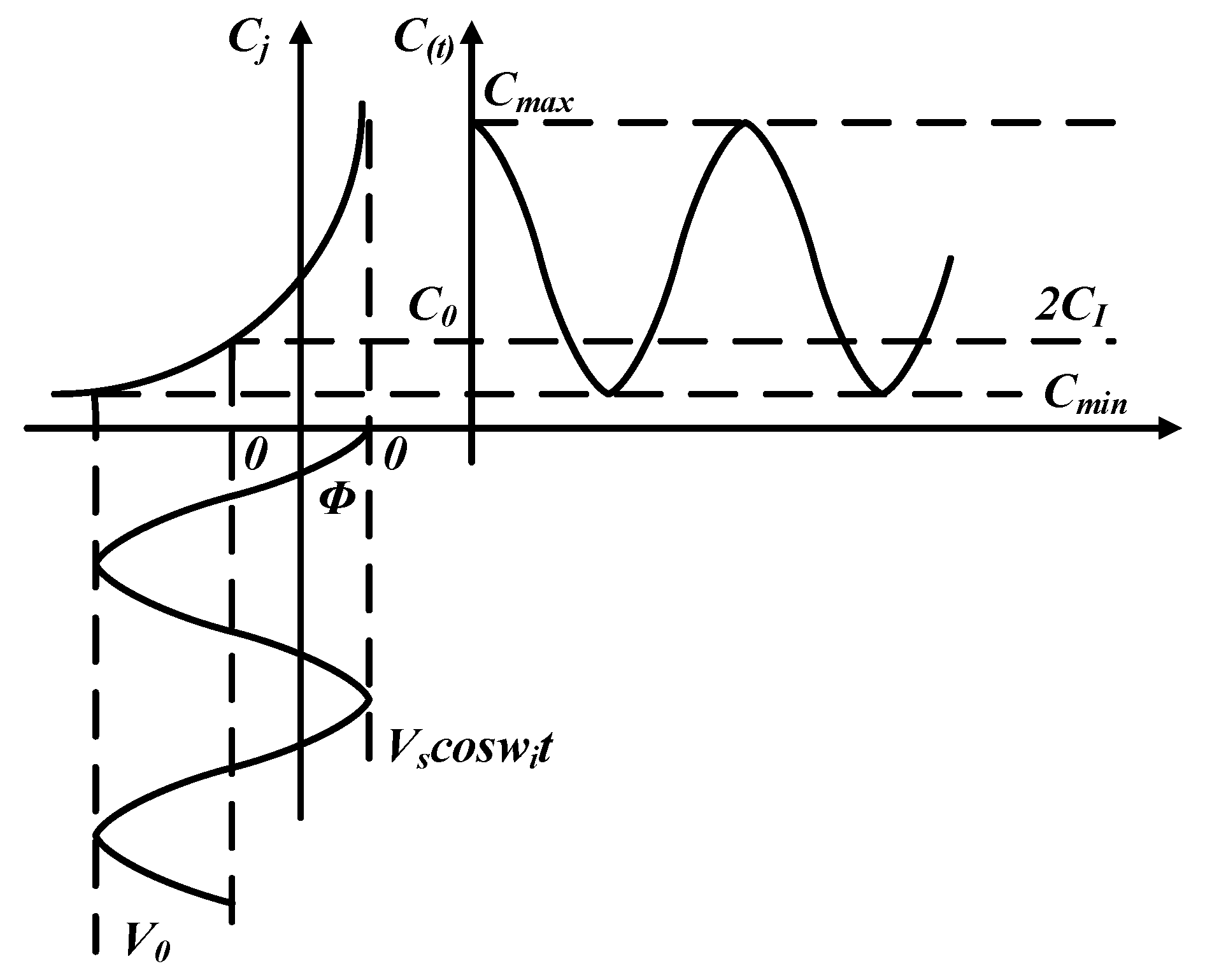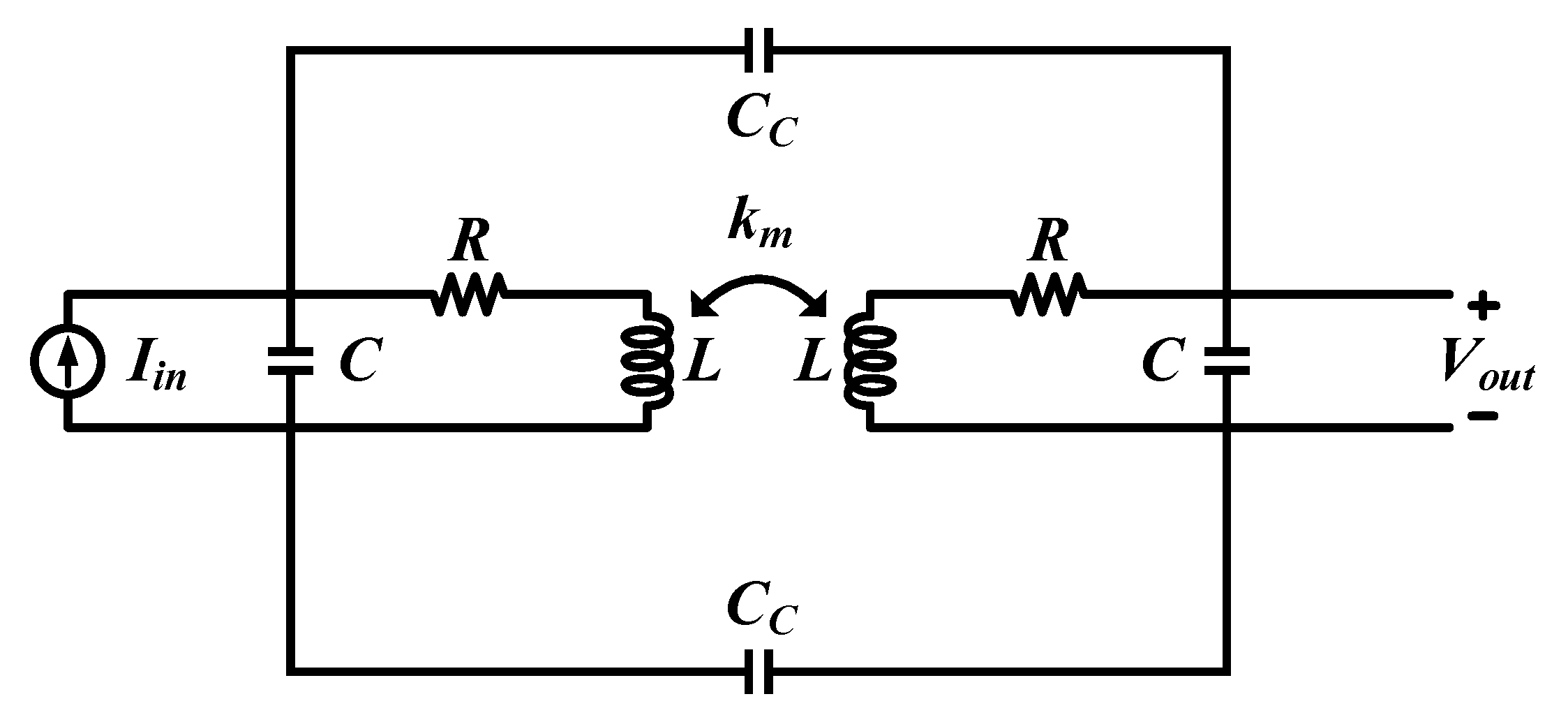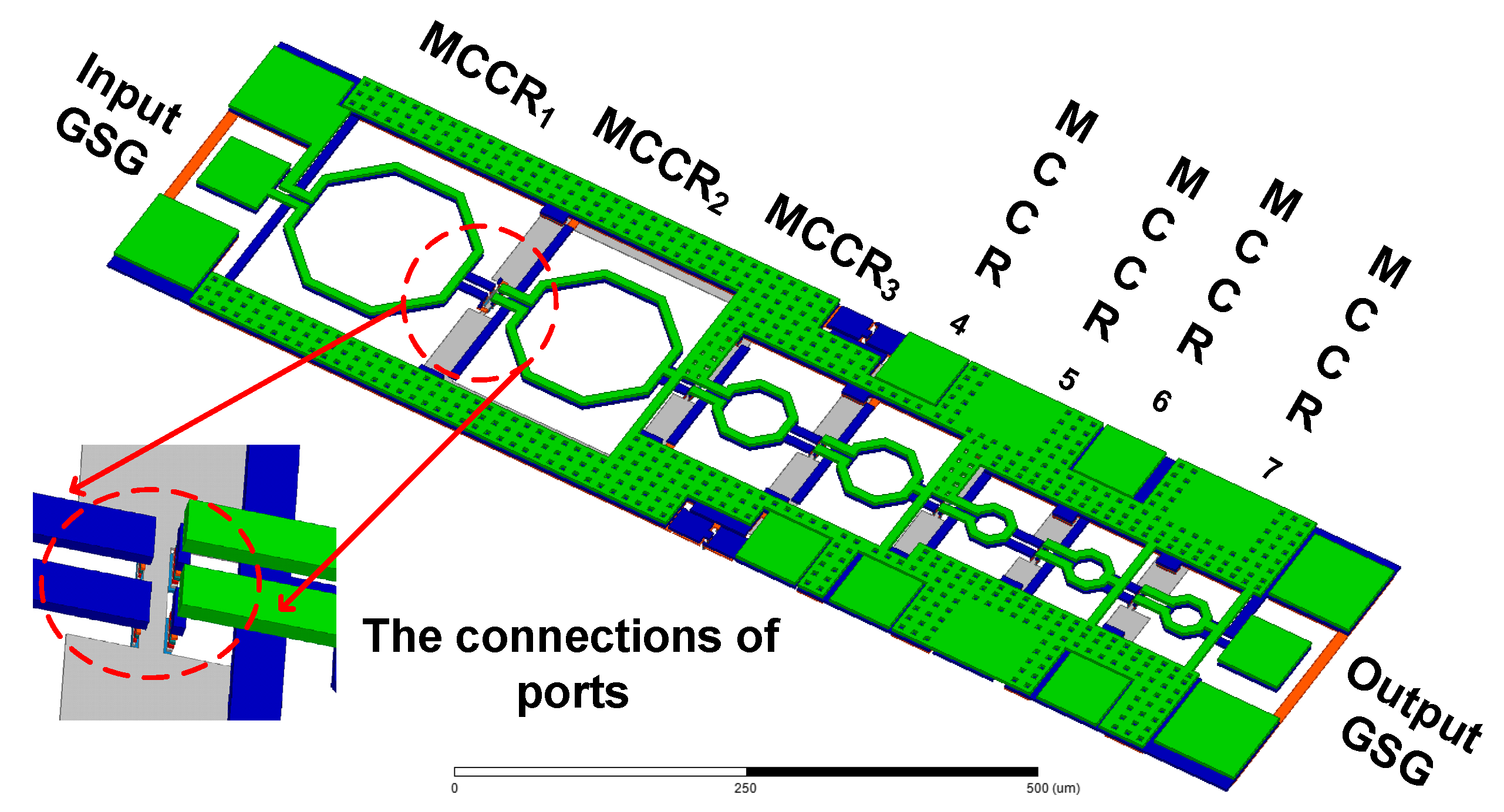A 130-to-220-GHz Frequency Quadrupler with 80 dB Dynamic Range for 6G Communication in 0.13-μm SiGe Process
Abstract
:1. Introduction
2. The Process of the 130-nm SiGe BiCMOS Technology and Device Modeling
3. The Proposed FQ Circuits
3.1. The Working Principle of the Frequency Doubler
3.2. The Matching Network Analysis and Power Amplifier Driver
3.3. The Proposed Driver Circuit and QA Circuit
4. Measurement Results
5. Conclusions
Author Contributions
Funding
Data Availability Statement
Conflicts of Interest
Abbreviations
| SiGe | Silicon-Germanium |
| FQ | Frequency Quadrupler |
| PA | Power Amplifier |
| MCCR | Magnetically And Capacitively Coupled Resonator |
| CML | Current Mode Logic |
| VCO | Voltage-Controlled Oscillator |
| BEOL | Back-End-Of-The-Line |
| EM | Electromagnetic |
| HBT | Hetero-Junction Bipolar Transistor |
| ESD | Electro-Static Discharge |
| HFSS | High Frequency Structure Simulator |
| RF | Radio Frequency |
| BJT | Bipolar Junction Transistor |
| PCPP | Phase-Controlled Push-Push |
| PP | Push-Push |
| CMOS | Complementary Metal Oxide Semiconductor |
References
- Park, J.; Kang, S.; Niknejad, A.M. A 0.38 THz Fully Integrated Transceiver Utilizing a Quadrature Push-Push Harmonic Circuitry in SiGe BiCMOS. IEEE J. Solid-State Circuits 2012, 47, 2344–2354. [Google Scholar] [CrossRef]
- Aghasi, H.; Cathelin, A.; Afshari, E. A 0.92-THz SiGe Power Radiator Based on a Nonlinear Theory for Harmonic Generation. IEEE J. Solid-State Circuits 2017, 52, 406–422. [Google Scholar] [CrossRef]
- Ng, H.J.; Hasan, R.; Kissinger, D. A Scalable Four-Channel Frequency-Division Multiplexing MIMO Radar Utilizing Single-Sideband Delta–Sigma Modulation. IEEE Trans. Microw. Theory Tech. 2019, 67, 4578–4590. [Google Scholar] [CrossRef]
- Ng, H.J.; Kissinger, D. Highly Miniaturized 120-GHz SIMO and MIMO Radar Sensor with On-Chip Folded Dipole An-tennas for Range and Angular Measurements. IEEE Trans. Microw. Theory Tech. 2018, 66, 2592–2603. [Google Scholar] [CrossRef]
- Centurelli, F.; Monsurrò, P.; Scotti, G.; Tommasino, P.; Trifiletti, A. A Power Efficient Frequency Divider with 55 GHz Self-Oscillating Frequency in SiGe BiCMOS. Electronics 2020, 9, 1968. [Google Scholar] [CrossRef]
- Silva Valdecasa, G.; Altabas, J.A.; Kupska, M.; Jensen, J.B.; Johansen, T.K. A 5–50 GHz SiGe BiCMOS Linear Transimpedance Amplifier with 68 dBΩ Differential Gain towards Highly Integrated Quasi-Coherent Receivers. Electronics 2021, 10, 2349. [Google Scholar] [CrossRef]
- Chen, Z.; Hou, D.; Chen, J.-X.; Yan, P.; Bao, L.; Hong, Z.; Zheng, Y. A K-Band FMCW Frequency Synthesizer Using Q-Boosted Switched Inductor VCO in SiGe BiCMOS for 77 GHz Radar Applications. Electronics 2020, 9, 1933. [Google Scholar] [CrossRef]
- Men, K.; Liu, H.; Yeo, K.S. Design of a Ka-Band U-Shaped Bandpass Filter with 20-GHz Bandwidth in 0.13-μm BiCMOS Technology. Electronics 2020, 9, 1608. [Google Scholar] [CrossRef]
- Coen, C.T.; Frounchi, M.; Lourenco, N.E.; Cheon, C.D.Y.; Williams, W.L.; Cressler, J.D. A 60-GHz SiGe Radiometer Calibration Switch Utilizing a Coupled Avalanche Noise Source. IEEE Microw. Wirel. Compon. Lett. 2020, 30, 417–420. [Google Scholar] [CrossRef]
- Han, J.; Jiang, Y.; Guo, G.; Cheng, X. A Reconfigurable Analog Baseband Circuitry for LFMCW RADAR Receivers in 130-nm SiGe BiCMOS Process. Electronics 2020, 9, 831. [Google Scholar] [CrossRef]
- Kibaroglu, K.; Sayginer, M.; Rebeiz, G.M. A 28 GHz transceiver chip for 5G beamforming data links in SiGe BiCMOS. In Proceedings of the 2017 IEEE Bipolar/BiCMOS Circuits and Technology Meeting (BCTM), Miami, FL, USA, 19–21 October 2017; pp. 74–77. [Google Scholar] [CrossRef]
- Grzyb, J.; Heinemann, B.; Pfeiffer, U.R. Solid-State Terahertz Superresolution Imaging Device in 130-nm SiGe BiCMOS Technology. IEEE Trans. Microw. Theory Tech. 2017, 65, 4357–4372. [Google Scholar] [CrossRef]
- Chung, W.; Kim, C.; Kim, S.S.; Hong, S. Design of 94-GHz Highly Efficient Frequency Octupler Using 47-GHz Current-Reusing Class-C Frequency Quadrupler. IEEE Trans. Microw. Theory Tech. 2020, 68, 775–784. [Google Scholar] [CrossRef]
- Golcuk, F.; Gurbuz, O.D.; Rebeiz, G.M. A 0.39–0.44 THz 2x4 Amplifier-Quadrupler Array with Peak EIRP of 3–4 dBm. IEEE Trans. Microw. Theory Tech. 2013, 61, 4483–4491. [Google Scholar] [CrossRef]
- Wu, L.; Liao, S.; Xue, Q. A 312-GHz CMOS Injection-Locked Radiator with Chip-and-Package Distributed Antenna. IEEE J. Solid-State Circuits 2017, 52, 2920–2933. [Google Scholar] [CrossRef]
- Yang, Y.; Gurbuz, O.D.; Rebeiz, G.M. An Eight-Element 370–410-GHz Phased-Array Transmitter in 45-nm CMOS SOI with Peak EIRP of 8–8.5 dBm. IEEE Trans. Microw. Theory Tech. 2016, 64, 4241–4249. [Google Scholar] [CrossRef]
- Cao, T.; Liu, Y.J.; Jiang, J.; Zhang, Q.; Lin, C.; Yang, D.; Zhang, G.; Yang, C.; Zhou, J. Frequency Multiplier-Based Millimeter-Wave Vector Signal Transmitter Using Digital Predistortion with Constrained Feedback Bandwidth. IEEE Trans. Microw. Theory Tech. 2020, 68, 1819–1829. [Google Scholar] [CrossRef]
- Jaffri, I.; Ayed, A.B.; Darwish, A.M.; Mitran, P.; Boumaiza, S. Novel Baseband Equivalent Model for Digital Predistortion of Wideband Frequency-Multiplier-Based Millimeter Wave Sources. IEEE Trans. Microw. Theory Tech. 2020, 68, 3942–3957. [Google Scholar] [CrossRef]
- Bousnina, S.; Mandeville, P.; Kouki, A.B.; Surridge, R.; Ghannouchi, F.M. Direct parameter-extraction method for HBT small-signal model. IEEE Trans. Microw. Theory Tech. 2002, 50, 529–536. [Google Scholar] [CrossRef]
- Kim, W.; Kang, S.; Lee, K.; Chung, M.; Kang, J.; Kim, B. Analysis of nonlinear behavior of power HBTs. IEEE Trans. Microw. Theory Tech. 2002, 50, 1714–1722. [Google Scholar]
- Sheinman, B.; Wasige, E.; Rudolph, M.; Doerner, R.; Sidorov, V.; Cohen, S.; Ritter, D. A peeling algorithm for extraction of the HBT small-signal equivalent circuit. IEEE Trans. Microw. Theory Tech. 2002, 50, 2804–2810. [Google Scholar] [CrossRef]
- Li, S.; Huang, M.; Jung, D.; Huang, T.; Wang, H. A 28 GHz Current-Mode Inverse-Outphasing Transmitter Achieving 40%/31% PA Efficiency at Psat/6 dB PBO and Supporting 15 Gbit/s 64-QAM for 5G Communication. In Proceedings of the 2020 IEEE International Solid-State Circuits Conference (ISSCC), San Francisco, CA, USA, 16–20 February 2020; pp. 365–368. [Google Scholar]
- Huang, D.; LaRocca, T.R.; Samoska, L.; Fung, A.; Chang, M.F. 324 GHz CMOS Frequency Generator Using Linear Superposition Technique. In Proceedings of the 2008 IEEE International Solid-State Circuits Conference, San Francisco, CA, USA, 3–7 February 2008; pp. 476–629. [Google Scholar]
- Wang, Y.; Goh, W.L.; Xiong, Y. A 9% power efficiency 121-to-137 GHz phase-controlled push-push frequency quadrupler in 0.13μm SiGe BiCMOS. In Proceedings of the 2012 IEEE International Solid-State Circuits Conference, San Francisco, CA, USA, 19–23 February 2012; pp. 262–264. [Google Scholar]
- Ku, B.; Chung, H.; Rebeiz, G.M. A Milliwatt-Level 70–110 GHz Frequency Quadrupler with >30 dBc Harmonic Rejection. IEEE Trans. Microw. Theory Tech. 2018, 68, 1697–1705. [Google Scholar] [CrossRef]
- Kucharski, M.; Eissa, M.H.; Malignaggi, A.; Wang, D.; Ng, H.J.; Kissinger, D. D-Band Frequency Quadruplers in BiCMOS Technology. IEEE J. Solid-State Circuits 2018, 53, 2465–2478. [Google Scholar] [CrossRef]
- Wu, K.; Mansha, M.W.; Hella, M. A 99–132 GHz Frequency Quadrupler with 8.5 dBm Peak Output Power and 8.8% DC-to-RF Efficiency in 130 nm BiCMOS. In Proceedings of the 2020 IEEE/MTT-S International Microwave Symposium (IMS), Los Angeles, CA, USA, 4–6 August 2020; pp. 476–479. [Google Scholar]
- Steinweg, L.; Rieß, V.; Stärke, P.; Testa, P.V.; Carta, C.; Ellinger, F. A Low-Power 255-GHz Single-Stage Frequency Quadrupler in 130-nm SiGe BiCMOS. IEEE Microw. Wirel. Compon. Lett. 2020, 30, 1101–1104. [Google Scholar] [CrossRef]
- Stärke, P.; Rieß, V.; Carta, C.; Ellinger, F. Frequency Multiplier-by-4 (Quadrupler) with 52 dB Spurious-Free Dynamic Range for 152 GHz to 220 GHz (G-Band) in 130 nm SiGe. In Proceedings of the 2020 IEEE Radio Frequency Integrated Circuits Symposium (RFIC), Los Angeles, CA, USA, 4–6 August 2020; pp. 251–254. [Google Scholar]
- Ali, A.; Yun, J.; Ng, H.J.; Kissinger, D.; Giannini, F.; Colantonio, P. Wideband Frequency Quadrupler for D-Band Applications in BiCMOS Technology. In Proceedings of the 2020 23rd International Microwave and Radar Conference (MIKON), Warsaw, Poland, 5–8 October 2020; pp. 229–231. [Google Scholar]
- Jamal, F.I.; Eissa, M.H.; Borngräber, J.; Ng, H.J.; Kissinger, D.; Wessel, J. A low-power 190–255 GHz frequency quadrupler in SiGe BiCMOS technology for on-chip spectroscopic applications. In Proceedings of the 2017 IEEE Radio and Wireless Symposium (RWS), Phoenix, AZ, USA, 15–18 January 2017; pp. 94–97. [Google Scholar]
- Liang, Y.; Boon, C.C.; Zhang, H.; Tang, X.; Zhang, Q.; Yu, H. A 13.5-Gb/s 140-GHz Silicon Redriver Exploiting Metadevices for Short-Range OOK Communications. IEEE Trans. Microw. Theory Tech. 2020, 1, 239–253. [Google Scholar] [CrossRef]
- Ma, S.; Lin, J.; Ma, C.; Yu, H. A 140 GHz Transceiver for 4 × 4 Beamforming Short-Range Communication in 65 nm CMOS. In Proceedings of the 2019 IEEE Asia-Pacific Microwave Conference (APMC), Singapore, 10–13 December 2019; pp. 1613–1615. [Google Scholar]

















| Stage of n-p-n | Size of n-p-n Transistor | |
| M | Emitter Width (nm)—70 | |
| 1 | 6 | Emitter Length (nm)—900 |
| 2 | 6 | STI (nm)—440 |
| 3 | 4 | baspolyx (nm)—300 |
| 4 | 4 | bipwinx (nm)—70 |
| 5 | 4 | bipwiny (nm)—100 |
| 6 | 4 | empolyx (nm)—150 |
| empolyy (nm)—180 | ||
| Active transistors design for quadrature | ||
| Reference | Method | Technology | Freq. (GHz) | N | Gain (dB) | Pout (dBm) | PDC (mW) | Input Buffers | Output Buffers | η (%) |
|---|---|---|---|---|---|---|---|---|---|---|
| [23] | LS | 90 nm CMOS a | 322–326 | 4 | N | −46 | 12 | N | N | 0.0002 |
| [24] | PCPP b | 0.13 μm SiGe | 121–137 | ×4 | 0.6 | −2.4 | 35.2 | Y | N | 1.6 |
| [25] | Cascaded Doubler | 0.12 μm SiGe | 70–110 | ×4 | −4.5 | −4.5 | 240 | N | N | 0.3–0.8 |
| [26] | Injection-locked | 0.13 μm SiGe | 148–183 | ×4 | 5 | −4 | 49 | N | N | 0.8 |
| [27] | Cascaded Doubler | 0.13 μm SiGe | 99–132 | ×4 | N | 8.5 | 79.2 | N | N | 8.8 |
| [28] | PCPP b | 0.13 μm SiGe | 248–262 | ×4 | N | −8.4 | 22.4 | N | N | 0.65 |
| [29] | PP c | 0.13 μm SiGe | 152–220 | ×4 | N | −1 | 45 | N | Y | 1.8 |
| [30] | Cascaded Doubler | 0.13 μm SiGe | 100–184 | ×4 | 25 | 5@130 | 42 | N | N | 7.5 |
| [31] | PP | 0.13 μm SiGe | 190–255 | ×4 | −24.4 | −16.4 | 48 | N | N | 0.048 |
| This work | MCCR + HIM | 0.13 μm SiGe | 130–220 | ×4 | 16 | 1.86@210 GHz | 42 | Y | Y | 3.7@210 GHz |
Publisher’s Note: MDPI stays neutral with regard to jurisdictional claims in published maps and institutional affiliations. |
© 2022 by the authors. Licensee MDPI, Basel, Switzerland. This article is an open access article distributed under the terms and conditions of the Creative Commons Attribution (CC BY) license (https://creativecommons.org/licenses/by/4.0/).
Share and Cite
Wu, T.; Cao, Z.; Xu, Z.; Dai, L.; Mao, W.; He, J.; Ma, S.; Yu, H. A 130-to-220-GHz Frequency Quadrupler with 80 dB Dynamic Range for 6G Communication in 0.13-μm SiGe Process. Electronics 2022, 11, 825. https://doi.org/10.3390/electronics11050825
Wu T, Cao Z, Xu Z, Dai L, Mao W, He J, Ma S, Yu H. A 130-to-220-GHz Frequency Quadrupler with 80 dB Dynamic Range for 6G Communication in 0.13-μm SiGe Process. Electronics. 2022; 11(5):825. https://doi.org/10.3390/electronics11050825
Chicago/Turabian StyleWu, Tianxiang, Zhiyuan Cao, Zhuofan Xu, Liuyao Dai, Wei Mao, Jin He, Shunli Ma, and Hao Yu. 2022. "A 130-to-220-GHz Frequency Quadrupler with 80 dB Dynamic Range for 6G Communication in 0.13-μm SiGe Process" Electronics 11, no. 5: 825. https://doi.org/10.3390/electronics11050825
APA StyleWu, T., Cao, Z., Xu, Z., Dai, L., Mao, W., He, J., Ma, S., & Yu, H. (2022). A 130-to-220-GHz Frequency Quadrupler with 80 dB Dynamic Range for 6G Communication in 0.13-μm SiGe Process. Electronics, 11(5), 825. https://doi.org/10.3390/electronics11050825





